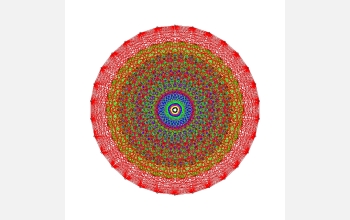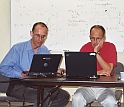|

Press Release 07-029
A Mathematical Solution for Another Dimension

New tool could drive breakthroughs in several disciplines
March 19, 2007
Ever since 1887, when Norwegian mathematician Sophus Lie discovered the mathematical group called E8, researchers have been trying to understand the extraordinarily complex object described by a numerical matrix of more than 400,000 rows and columns.
Now, an international team of experts using powerful computers and programming techniques has mapped E8--a feat numerically akin to the mapping of the human genome--allowing for breakthroughs in a wide range of problems in geometry, number theory and the physics of string theory.
"Although mapping the human genome was of fundamental importance in biology, it doesn't instantly give you a miracle drug or a cure for cancer" said mathematician Jeffrey Adams, project leader and mathematics professor at the University of Maryland. "This research is similar: it is critical basic research, but its implications may not become known for many years."
Team member David Vogan, a professor of mathematics at the Massachusetts Institute of Technology (MIT), presented the findings today at MIT.
The effort to map E8 is part of a larger project to map out all of the Lie groups--mathematical descriptions of symmetry for continuous objects like cones, spheres and their higher-dimensional counterparts. Many of the groups are well understood; E8 is the most complex.
The project is funded by the National Science Foundation (NSF) through the American Institute of Mathematics.
It is fairly easy to understand the symmetry of a square, for example. The group has only two components, the mirror images across the diagonals and the mirror images that result when the square is cut in half midway through any of its sides. The symmetries form a group with only those 2 degrees of freedom, or dimensions, as members.
A continuous symmetrical object like a sphere is 2-dimensional on its surface, for it takes only two coordinates (latitude and longitude on the Earth) to define a location. But in space, it can be rotated about three axes (an x-axis, y-axis and z-axis), so the symmetry group has three dimensions.
In that context, E8 strains the imagination. The symmetries represent a 57-dimensional solid (it would take 57 coordinates to define a location), and the group of symmetries has a whopping 248 dimensions.
Because of its size and complexity, the E8 calculation ultimately took about 77 hours on the supercomputer Sage and created a file 60 gigabytes in size. For comparison, the human genome is less than a gigabyte in size. In fact, if written out on paper in a small font, the E8 answer would cover an area the size of Manhattan.
While even consumer hard drives can store that much data, the computer had to have continuous access to tens of gigabytes of data in its random access memory (the RAM in a personal computer), something far beyond that of home computers and unavailable in any computer until recently.
The computation was sophisticated and demanded experts with a range of experiences who could develop both new mathematical techniques and new programming methods. Yet despite numerous computer crashes, both for hardware and software problems, at 9 a.m. on Jan. 8, 2007, the calculation of E8 was complete.
-NSF-
The Atlas team consists of 18 researchers from the United States and Europe. The core group consists of Jeffrey Adams (University of Maryland), Dan Barbasch (Cornell), John Stembridge (University of Michigan), Peter Trapa (University of Utah) , Marc van Leeuwen (Poitiers), David Vogan (MIT), and (until his death in 2006) Fokko du Cloux (Lyon). For details on E8, visit http://aimath.org/E8/.
The Atlas of Lie Groups Project
The E8 calcuation is part of an ambitious project sponsored by AIM and the National Science Foundation (NSF), known as the Atlas of Lie Groups and Representations. The goal of the Atlas project is to determine the unitary representations of all the Lie groups (E8 is the largest of the exceptional Lie groups). This is one of the most important unsolved problems of mathematics. The E8 calculation is a major step, and suggests that the Atlas team
is well on the way to solving this problem. The Atlas project is funded by the NSF through the American Institute of Mathematics.
The American Institute of Mathematics
The American Institute of Mathematics, a nonprofit organization, was founded in 1994 by Silicon Valley businessmen John Fry and Steve Sorenson, longtime supporters of mathematical research. AIM is one of seven mathematics institutes supported by the NSF. AIM's goals are to expand the frontiers of mathematical knowledge through focused research projects, by sponsoring conferences, and helping to develop the leaders of tomorrow. In addition, AIM is interested in helping preserve the history of mathematics through the acquisition and preservation of rare mathematical books and documents and in making these materials available to scholars of mathematical history. AIM currently resides in temporary facilities in Palo Alto, California, the former Fry's Electronics headquarters. A new facility is being constructed in Morgan Hill, California. For more information, visit www.aimath.org.
This research was supported by the following three NSF awards:
DMS 0554278 FRG: Collaborative Research: Atlas of Lie Groups and Representations
DMS 0532393 Atlas of Lie Groups
DMS 0532088 Atlas of Lie Groups and Representations

Media Contacts
Joshua A. Chamot, NSF (703) 292-7730 jchamot@nsf.gov
Brian Conrey, American Institute of Mathematics (650) 845-2071 conrey@aimath.org
Program Contacts
Joe W. Jenkins, NSF (703) 292-4870 jjenkins@nsf.gov
Principal Investigators
Jeffrey Adams, University of Maryland (301) 405-5493 jda@math.umd.edu
Related Websites
David Vogan's March 19 presentation: http://www-math.mit.edu/~dav/E8TALK.pdf

The National Science Foundation (NSF) is an independent federal agency that
supports fundamental research and education across all fields of science and
engineering, with an annual budget of $6.06 billion. NSF funds reach all 50
states through grants to over 1,900 universities and institutions. Each year,
NSF receives about 45,000 competitive requests for funding, and makes over
11,500 new funding awards. NSF also awards over $400 million in
professional and service contracts yearly.
 Get News Updates by Email Get News Updates by Email
Useful NSF Web Sites:
NSF Home Page: http://www.nsf.gov
NSF News: http://www.nsf.gov/news/
For the News Media: http://www.nsf.gov/news/newsroom.jsp
Science and Engineering Statistics: http://www.nsf.gov/statistics/
Awards Searches: http://www.nsf.gov/awardsearch/
| 



